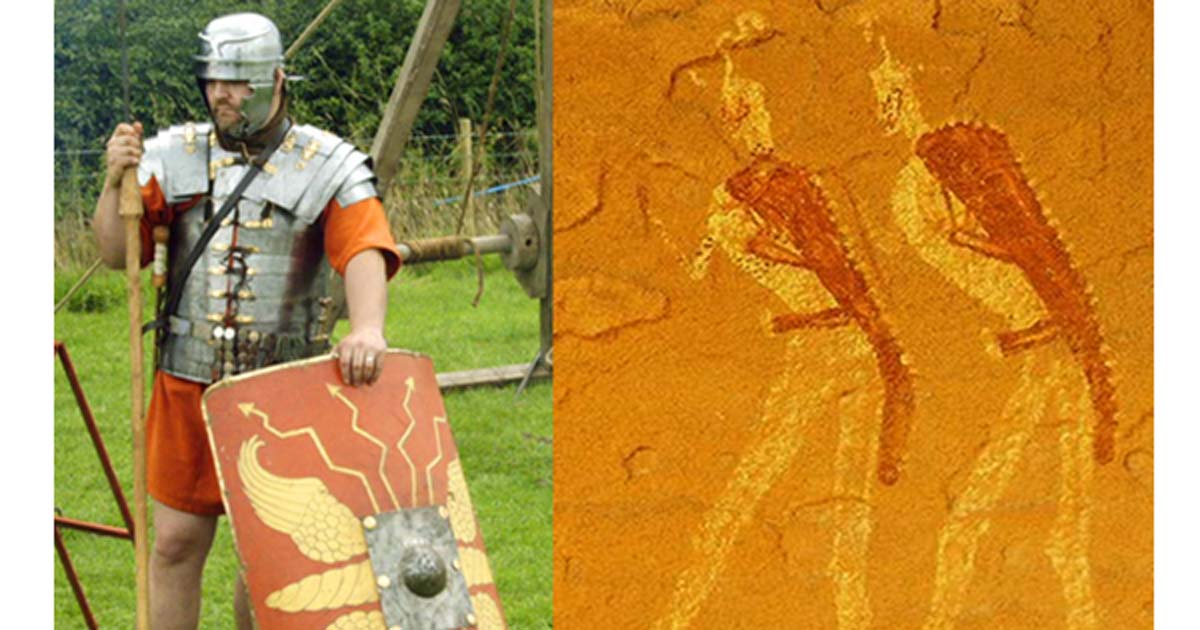The Giant of Algeria: Iconographic Evidence of Roman Expeditions in the Sahara
There are thousands of rock engravings at the dramatic rocky landscape of Jabbaren, Algeria. Jabbaren is an archaeological site in the Tassili N'ajjer National Park in Algeria with some of the most important groupings of prehistoric cave art in the world. The Jabbaren site is situated on the lower level of the Tassili plateau, and in the Tamahaq language Jabbaren means “giant”. It is interesting to note that some of the engraved figures from Jabbaren appear to be Roman soldiers.

Rock Art of the Tassili n'Ajjer, Jabbaren, Algeria. (CC BY-SA 2.0)

Algerian desert - Tassili National Park. (CC BY 2.0)
Anthropology researcher and Tassili N’ajjer park director, Malika Hachid has dated many of the rock engravings at Jabbaren to be thousands of years old. They include pictures of cattle and people.

Dancing figures and animals. (Fondazione Passaré/CC BY-SA 3.0)

Rock art at Tassili n'Ajjer (Via author)

Detail; Image exposed for clarity. Rock art at Tassili n'Ajjer (Via author)
Roman Conquest
The Roman sent many expeditions against the Kushites or Meroites. Ther Meroites and Romans were often in competition to dominate Lower Egypt.
Cornelius Gallus was the prefect of Egypt, appointed by Emperor Augustus. Gallus was responsible for subduing the island of Philae and returning it to Roman, instead of Kushite, rule. From Philae, Gallus made a pre-empted attack on the Meroites.

A scene on the island of Philae, Egypt, before 1923. (Public Domain)
The Meroites sent envoys to Philae to negotiate with Gallus to the end the conflict that had begun in 29 BC. At Philae. Gallus has left us inscriptions in Latin and hieroglyphics detailing his victory over the Meroites.
- Buddhism in Ancient Egypt and Meroe – Beliefs Revealed Through Ancient Script
- Ancient Tomb Reveals Cultural Entanglement between Egypt and Nubia
- The Elephant Slabs of Flora Vista: Enigmatic Artifacts with Ancient African Origins
John D. Grainger, in Egypt and Judaea, made it clear that in the Philae inscriptions Gallus claimed ‘he pacified the chiefs of Kush’. He made it clear that his conquest of the Meroites was in the name of Octavius. By 27 BC Gallus was replaced by Aelius Gallus.
Following the orders of Augustus in 25 BC, the second prefect of Roman Egypt Aelius Gallus headed an expedition that was to find a route from Egypt to Arabia Felix through the desert. The expedition was a failure. As a result of disease, Aelius lost most of his forces, and was forced to return to Alexandria after only six months.
The King of Meroe, according to Strabo, sent and army to conquer Egypt and retake Philae and the Triacontaschoinos (or the ‘Thirty Mile Land’ going south from Philae), while Aelius Gallus was in Arabia. The Meroites retook Syene (modern Aswan) and the Islands of Philae and Elephantine.
Aelius Gallus was replaced by P. Petronius who led a counter attack in 22BC. Petronius recovered the lost territory and the Meroites were pushed back to Pselchis.
The Romans were able to capture the Meroitic religious center at Napata. Petronius later took Qasr Ibrim, which he fortified and then left a Roman garrison to protect Roman interests in the area. Later the Meroites signed a peace treaty on the Greek island of Samos, with Augustus ending the war.
Malika Hachid, in Les Tassili des Ajjer: Cinquante Siècles avant les pyramide, published the rock art from the Sahara, at Jabbaren featuring Roman soldiers. Hachid has implied that all of the rock art has great antiquity, perhaps three to four thousand years old, but indeed some of the figures appear to date back to the Roman period in Africa.

Rock art at Jabbaren. (Via author)
The above figures are probably of Roman soldiers that became lost in the Sahara during the campaigns of C. Gallus and Petronius. Although, researchers have assumed these are figures of Berbers, they may represent Roman legionary . A comparison of the figures from Jabarren and legionnaires support this view.
The Roman Legionnaires
The engraving or paintings from Jabbaren are probably of Roman soldiers marching. It is not ancient. This is obvious when we examine the figure in the rock art. First let’s look at the gear and military equipment of the average Roman soldier.

Roman Centurion reenactor with crested helmet. (CC BY-SA 3.0)

Left, Roman legionnaire reenactor in period gear. (CC BY 1.0). Right, Jabbaren rock painting.

When we compare the elements in the rock art we can see the details clearly of the Roman soldier’s uniform.
- The Loa Giants: Impressive and Enigmatic Geoglyphs in Northern Chile
- Expert in Chinese Petroglyphs Supports Theory Ancient Chinese Made It to America
- Who Made the Petroglyphs on the Mysterious Dighton Rock?
The rock drawing of Roman soldiers does not date back to the Bovidian period. These Jabbaren engravings are not of ancient Berbers— they represent the Roman soldier, probably dating back to the Gallus and Petronius expeditions.
Some of the Jabbaren figures show the regalia of the Roman legionary: the crest on the helmet, the shield carried on the back along with the cloak/tunic/toga. The Roman soldiers at Jabbaren appear to be marching double-time.
Is there iconographic evidence of Roman exploration of the Sahara? The answer appears to be yes.
--
Top Image: Deriv; Left, Roman legionnaire reenactor in period gear. (CC BY 1.0). Right, Jabbaren rock painting (Via author)

















